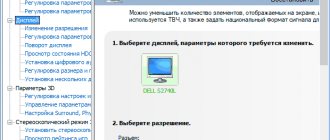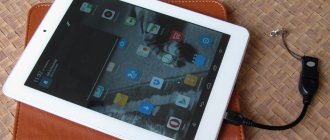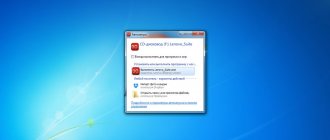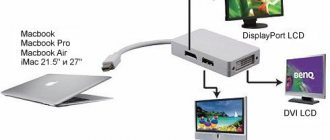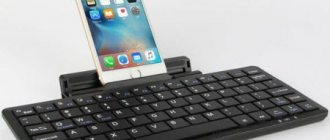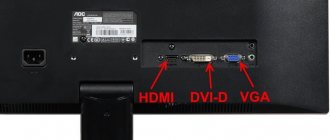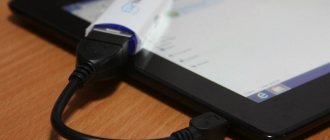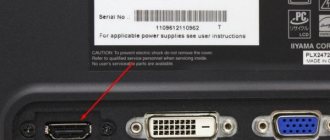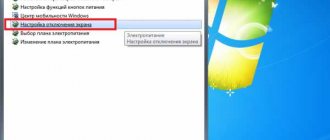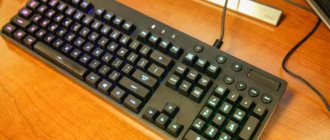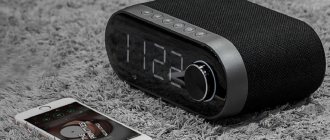Not enough work surface? Need an additional screen but don't have a monitor? There is a solution - a tablet or smartphone. So how to make a second monitor from it?
Sometimes, for comfortable work, there is not enough work surface on which to place, for example, a messenger or a browser. But an additional monitor means unexpected expenses and less desk space. However, there are situations in which an additional screen is simply necessary. Then it will come in handy... a smartphone or tablet!
Cable or WiFi?
To urgently expand the working surface, you can use a tablet; if you don’t have one, then even a smartphone will do. In addition to this, the device also needs the right software.
The free Wired XDisplay program from Splashtop will do the job perfectly. You will also need a wired connection to your computer - best using a USB cable and a USB 3.0 port (USB 2.0 can be used).
It is also possible to establish a wireless connection using programs such as Spacedesk or iDisplay. But the first program does not always work reliably, and the second is paid, so it is better to choose a cable.
What do we do to make everything work?
So, to use your tablet as a second monitor, you will need to install the appropriate software on both your computer and your mobile gadget. There are enough possible options for choosing this very software - Redfly ScreenSlider, Air Display, etc. We will focus on one of the proven and popular solutions - iDisplay . The choice of this particular utility is due to the fact that it is universal, available on Windows, OS X, Android, and iOS. Let's consider the popular Windows/Android combination; other options do not have any fundamental differences.
The first step is to download and install the appropriate software. The Windows version can be downloaded on the official website, the Android application can be downloaded from Google Play. By the way, the mobile application will cost you about $5, the desktop version is free. The installation process is unlikely to raise any questions for anyone, so let's move on to the setup.
Another important point. After installing the desktop part of the program, you need to restart your computer, otherwise you will be surprised for a long time and look for the reason that nothing is working.
Ways to use the iDisplay utility
There are two ways to use the iDisplay utility to connect your tablet to your PC - via USB or via Wi-Fi. The functionality does not change for different types of connection, only ease of use (still, extra wires are not always pleasant).
If you are using a USB connection, then after installing and launching iDisplay on both devices, indicate on the tablet your connection type - USB. If you don’t have a desire to get tangled up in wires, then without hesitation, make a choice in favor of Wi-Fi. Please note that the tablet and PC must be connected to the same local network.
In the application on the tablet, press the plus button to add your computer as a signal source. You will need to specify the IP address and port of the main machine (if you hover your mouse over the iDisplay icon near the clock, you will find out this data) and a name, which can be anything. Click “Add and connect”.
A connection request from your gadget should appear on the computer screen. There are three options for the request: reject, accept once, or save for the future to connect automatically. We advise you to choose the latter option for your own convenience. In addition, if you allow iDisplay to start at system startup, the tablet can easily replace the monitor in the event of any force majeure.
At this point, the computer screen may blink a couple of times, after which your desktop will appear on the tablet screen. You can now set up a second screen in Windows Desktop Settings, just as if you had actually connected another monitor to your computer. You can separately configure how the second display is used. It all depends on whether you will duplicate the image on it or expand the workspace to it.
By the way, an important point - by default, it is assumed that when expanded, the second working screen is to the right of the main one. But this can also be changed in the settings.
conclusions
In exactly the same way, you can connect not only a tablet, but also a smartphone, although the convenience of this solution is quite debatable. Still, for stationary, non-mobile use, the larger the diagonal, the more convenient. Nevertheless, there is such a possibility, which means that someone can find a use for it.
As you can see, there is nothing complicated about connecting a tablet as a second (or better yet, additional) monitor to your main computer. Anyone can do these few simple steps, and then think through scenarios for using such a combination in search of the optimal solution that suits them. Experiment and share this material with your friends!
Software installation
After preliminary installation of the software on the tablet and laptop or personal computer (an agent is needed on the computer - Wired XDisplay Agent), you need to launch both applications. You must first enable USB debugging on your tablet (not necessary for iOS users). Fortunately, the application itself reminds you of this and opens the necessary settings. And voila! Second screen connected!
Now you just need to connect the equipment. You should also keep in mind that the software will load your computer, so with a processor like the Intel Atom you may run into performance issues. You can eliminate this by setting the quality and performance settings to low.
Read also: How to crimp a twisted pair cable (RJ-45) yourself
How to connect a monitor to a tablet via USB?
Let's look at the first connection method via a USB cable. It’s immediately worth noting that there are two options for connecting the tablet:
- As a USB storage device (like a flash drive).
- As an additional display (like a computer via HDMI).
In the first case, you need a TV that supports USB drives. If there is one, then just connect the tablet to the TV using the standard cable that comes with any smartphone, tablet, etc. Then on the TV you need to select the connected device as the source, find the file to play and press Play.
In the second case, a TV with USB support is not needed, but you will need an adapter for the tablet. The simplest and most convenient option is an MHL adapter (micro-USB on one side and HDMI on the other). Most TVs support this technology, which allows you to stream data from your tablet on a screen or monitor. Thus, you can “stream” games, movies and music to the big screen and fully enjoy the content. Old monitors and TVs work either via USB to VGA or through composite adapters. This method is only suitable for tablets running Android version 4.0 and higher.
How does the second screen work?
After this you can start working. The device should perform in the same way as a standard monitor, however the quality and FPS may be reduced.
This particular software has some limitations. First, you need to use a USB cable and access a USB 3.0 port. However, not everyone wants to install an additional cable, and there is not always a free port. But quality depends on this. Secondly, there is a session time limit. In the free version of XDisplay, the session lasts up to 10 minutes, after which the program shuts down and must be started again. Of course, this is annoying and can discourage you from working with it.
How to use your tablet screen as a monitor
Almost any IT professional, and in principle some ordinary owners of a tablet, dream of putting it to good use - connecting it to the system unit so that information is displayed on the tablet as on a regular monitor. The first thing that comes to mind is to connect the tablet to the video card using an HDMI - miniHDMI cable, provided that the tablet and graphics card have these connectors.
After all, using an HDMI cable, a digital signal with multimedia data must be transmitted - video, sound, etc. But the problem is that the HDMI connector on the tablet is an output, not an input. Those. It can transmit an image to another device (for example, a monitor or TV), but cannot receive it.
For a very long time I was looking for a way to make a replacement monitor out of a tablet, and believe me, at least as of 2014, technically (at the hardware level) this will not be possible to implement, unless someone tries to solder an HDMI input into a tablet that receives a signal from a video card, or tablet manufacturers will come up with the idea themselves and start making tablets with universal HDMI, capable of both receiving and transmitting signals.
However, there is no need to be upset, because there is good news. You can turn your tablet into a main monitor at the software level. A special program will help the computer recognize the tablet as a monitor. There are three options for how you can use this “tablet monitor”:
- Complete replacement for a standard monitor. Can be used in emergency cases, for example, if a regular monitor is broken.
- The tablet can easily turn into an additional monitor to the main one. Everything that happens on the monitor can be duplicated on the tablet display.
- The tablet screen can become a “continuation” of the main monitor, i.e. for example, on a big screen you can watch a movie, and on a tablet screen you can read correspondence, control any computer program with a mouse and keyboard, read mail, and in general, do absolutely everything that you usually do on a computer.
Is it worth it?
If you urgently need an additional screen, then you can safely use this solution. It should be borne in mind that tablets have small screens, so the working surface will also be small. As noted, you can also use a smartphone for this, but the screen is even smaller and the work will not be comfortable enough.
Despite all the disadvantages outlined, this is a real way to cheaply and quickly increase your work surface. The software is free, and most users have a tablet or smartphone, as well as a USB cable to connect the devices to a computer. It is worth noting that the Wired XDisplay program is available for both the Android and Apple platforms, but it will not be available to users of tablets with Windows installed.
Why do you need an additional screen?
In principle, everything is already installed. The next steps depend on how you want to use the gadget. There are several options:
- Screen mirroring - right-click on the desktop and select "Screen Resolution". In the window that opens, in the “Multiple screens” column, select “Duplicate”.
- One large screen consisting of several monitors.
- Instead of duplicating, click on Expand. Then you will have, as it were, one desktop on both devices, but long and rectangular in shape. One information will be displayed on the PC monitor, and another on the tablet. Applications can be dragged across displays.
- Tablet as your main monitor – if you don’t want to turn on a bulky computer monitor at all. In the same column, select “Display the desktop only on the second one.” Then look for the iDisplay program on the track, click settings (in English settings) and check the box “Run Windows startup”. Again, restart the computer, turn off the large monitor, and let the program start automatically. On the tablet, turn on this program, and the desktop of your operating system will already be on the small screen.
Using Chromecast
Chromecast is a special device that connects to your TV via an HDMI cable. It receives signals from other gadgets and broadcasts them to the big screen. You can buy a Chromecast in the store; the gadget is more expensive than cables, but is considered convenient and mobile.
In addition, it can broadcast video and sound. The device is well marketed due to the ability to turn an old TV into an analogue of a modern gadget with the SMART-TV function. So, with the help of this repeater the user can get a high-quality image on the monitor.
- The user will need to purchase the device. It should be connected via an HDMI cable to a TV that is turned off from the network;
- In the TV settings you will need to select the source of the signal. Using the instructions inside the gadget's packaging, you should complete synchronization. It is necessary to test the devices; the image on the TV should duplicate the files played on the tablet.
The tablet can be synchronized not only with the TV, but also with a computer or laptop. You need to familiarize yourself with the device ports and purchase the necessary cable; connection is possible via USB ports. Some screen models can be connected using VGA plugs. In addition, synchronization via Wi-Fi is an available method, but uninterrupted data transfer is not guaranteed. To successfully connect two gadgets, you must follow the step-by-step instructions:
- You need to right-click on an empty space on the Desktop. A window will appear in which you need to select the “Screen Resolution” command. In the list you need to select the device with which synchronization occurs;
